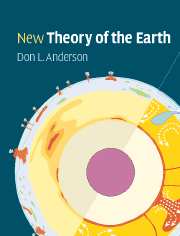Book contents
- Frontmatter
- Contents
- Preface and Philosophy
- Abbreviations and acronyms
- Part I Planetary perspective
- Part II Earth: the dynamic planet
- Part III Radial and lateral structure
- Chapter 8 Let's take it from the top: the crust and upper mantle
- Chapter 9 A laminated lumpy mantle
- Chapter 10 The bowels of the Earth
- Chapter 11 Geotomography: heterogeneity of the mantle
- Part IV Sampling the Earth
- Part V Mineral physics
- Part VI Origin and evolution of the layers and blobs
- Part VII Energetics
- References and notes
- Appendix
- Index
Chapter 11 - Geotomography: heterogeneity of the mantle
Published online by Cambridge University Press: 05 June 2012
- Frontmatter
- Contents
- Preface and Philosophy
- Abbreviations and acronyms
- Part I Planetary perspective
- Part II Earth: the dynamic planet
- Part III Radial and lateral structure
- Chapter 8 Let's take it from the top: the crust and upper mantle
- Chapter 9 A laminated lumpy mantle
- Chapter 10 The bowels of the Earth
- Chapter 11 Geotomography: heterogeneity of the mantle
- Part IV Sampling the Earth
- Part V Mineral physics
- Part VI Origin and evolution of the layers and blobs
- Part VII Energetics
- References and notes
- Appendix
- Index
Summary
You all do know this mantle.
Shakespeare (Julius Caesar)We must now admit that the Earth is not like an onion. It is time for some lateral thinking. One-dimensional radial variations in the mantle were responsible for what are now the standard one- and two-layer models of geodynamics and mantle geochemical reservoirs. The lateral variations of seismic velocity and density are as important as the radial variations. The shape of the Earth tells us this directly but provides little depth resolution. The long-wavelength geoid tells us that lateral density variations – and probable chemical variations – occur at great depth. Heat flow tells us that there are pronounced shallow variations in heat productivity, structure and physical properties. Lateral variations in the mantle affect the orientation of Earth in space and convection in the mantle and core. This property of the Earth is known as asphericity. It is best studied with seismic tomography. In the following chapters we further recognize that the Earth is neither elastic nor isotropic; it is anelastic and anisotropic. Long-wavelength lateral variations are revealed by global tomography. High-resolution seismic studies and scattering of high-frequency seismic waves complement the long-wavelength studies but are not consistent with the simple dynamic and chemical models based on older 1D or long-wavelength studies. Scattering may contribute to the anisotropy and attenuation of seismic waves in the upper mantle, and may help resolve the fates of recycled materials and the question of homogeneity of the upper mantle.
- Type
- Chapter
- Information
- New Theory of the Earth , pp. 124 - 140Publisher: Cambridge University PressPrint publication year: 2007



